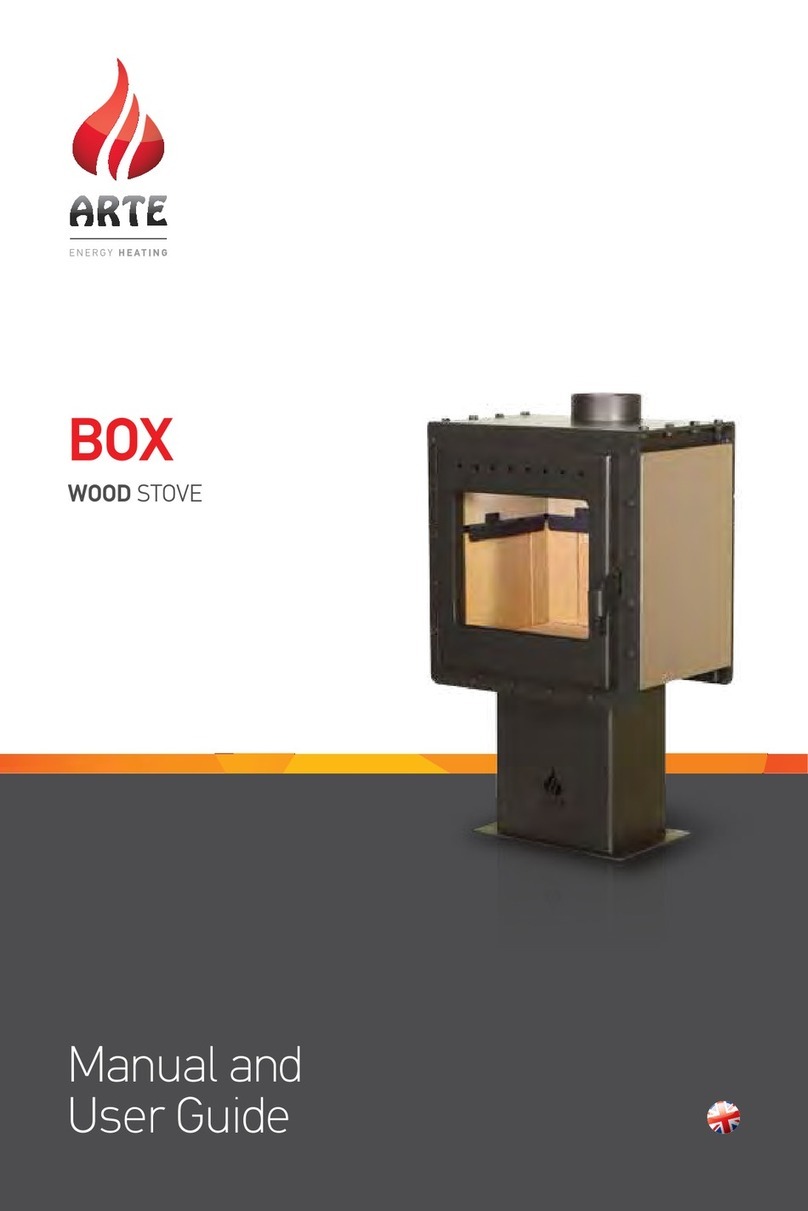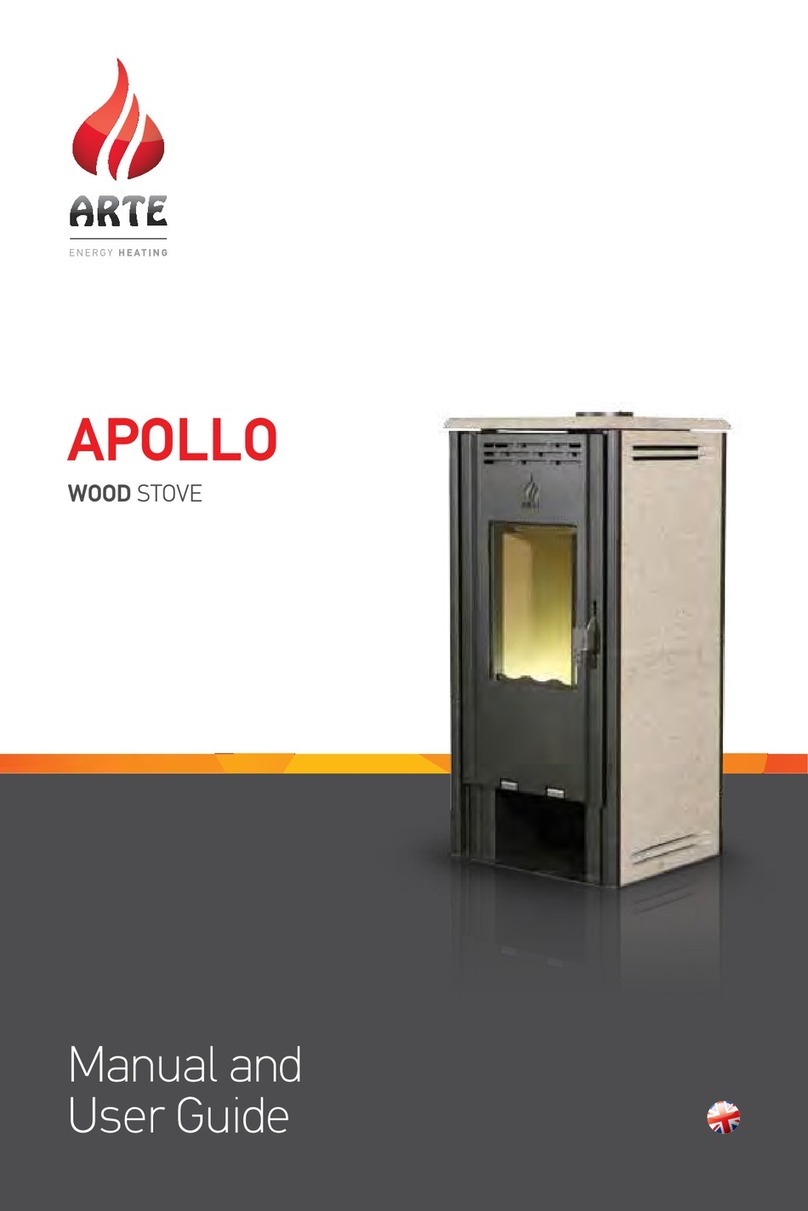
Table of contents
1. Arte® Wood stove - A Greek Quality Product........................................................................................................................................................... 2
2. Facts about wood and the environment................................................................................................................................................................... 2
2.1. Why use wood?...................................................................................................................................................................................................................... 2
2.2. Buying firewood...................................................................................................................................................................................................................... 2
2.3. Storing your wood .................................................................................................................................................................................................................. 2
2.4. Wood types and calorific value .......................................................................................................................................................................................... 3
2.5. Determining the heat output ............................................................................................................................................................................................... 4
3. Endorsements & Certifications ..................................................................................................................................................................................... 5
3.1. Endorsement........................................................................................................................................................................................................................... 5
3.2. Declaration of Performance CE .......................................................................................................................................................................................... 5
3.3. Features marking plate ......................................................................................................................................................................................................... 5
4. Packaging ....................................................................................................................................................................................................................... 5
4.1. Unpacking the stove.............................................................................................................................................................................................................. 5
5. Fire safety......................................................................................................................................................................................................................... 6
5.1. Safety distances ..................................................................................................................................................................................................................... 6
5.2. Wooden beams protection.................................................................................................................................................................................................. 6
5.3. General security instructions................................................................................................................................................................................................. 6
5.4. Flue security instructions ........................................................................................................................................................................................................ 6
5.4.1. Basic requirements for proper flue operation................................................................................................................................................................. 6
5.4.2. Chimney placement .......................................................................................................................................................................................................... 7
5.4.3. Chimney cap....................................................................................................................................................................................................................... 7
5.4.4. Flue pipe on the top or rear of the stove ........................................................................................................................................................................ 8
5.4.5. Malfunction - Secure woodstove shutdown................................................................................................................................................................... 8
6. Operating Instructions.................................................................................................................................................................................................... 8
6.1. Before initial use of an ARTE® PHOENIX woodstove ......................................................................................................................................................... 8
6.2. About ARTE® PHOENIX woodstove ..................................................................................................................................................................................... 9
6.3. General information .............................................................................................................................................................................................................. 9
6.3.1. When the woodstove paint dries ..................................................................................................................................................................................... 9
6.3.2. Incineration preparation.................................................................................................................................................................................................... 9
6.3.3. Combustion air intake........................................................................................................................................................................................................ 9
6.3.4. Heating during seasonal change or in adverse weather conditions ....................................................................................................................... 10
6.4. Ventilation kit (optional)...................................................................................................................................................................................................... 10
6.4.1. Ventilation kit installation (optional)............................................................................................................................................................................... 11
6.4.2. Air canals instalation (optional)...................................................................................................................................................................................... 12
6.4.3. Use of the electronic control panel ............................................................................................................................................................................... 13
7. Igniting the stove .......................................................................................................................................................................................................... 14
7.1. Traditional method of igniting ............................................................................................................................................................................................ 14
7.2. Igniting without CO emissions (TOP TO BOTTOM) ............................................................................................................................................................ 14
8. Tertiary combustion (patented)................................................................................................................................................................................. 15
9. Cleaning & Maintaining the Woodstove.................................................................................................................................................................. 16
9.1. External maintenance......................................................................................................................................................................................................... 16
9.2. Internal maintenance.......................................................................................................................................................................................................... 16
9.2.1. Ash disposal ....................................................................................................................................................................................................................... 16
9.2.2. Glass.................................................................................................................................................................................................................................... 16
9.2.3. Gasket ................................................................................................................................................................................................................................ 16
9.2.4. Internal parts that need maintenance.......................................................................................................................................................................... 16
9.3. Cleaning the woodstove and the flue ............................................................................................................................................................................. 17
9.3.1. Chimney sweeping........................................................................................................................................................................................................... 17
9.3.2. Annual maintenance....................................................................................................................................................................................................... 17
9.3.3. How to clean the inside parts of ARTE® PHOENIX woodstove................................................................................................................................... 17
9.4. Internal parts removal.......................................................................................................................................................................................................... 18
9.5. Inactive fireplace for prolonged periods ......................................................................................................................................................................... 18
10. Tips & Tricks for Resolving Issues................................................................................................................................................................................ 18
11. Dimensions................................................................................................................................................................................................................... 19
12. Technical Specifications............................................................................................................................................................................................ 20
13. Warranty ...................................................................................................................................................................................................................... 21
13.1. Warranty terms ................................................................................................................................................................................................................... 21
13.2. Excluded from the warranty............................................................................................................................................................................................. 21
13.3. Responsibility....................................................................................................................................................................................................................... 21
13.4. Emergency maintenance................................................................................................................................................................................................. 21
13.5. Responsibility for installation ............................................................................................................................................................................................. 21
13.6. Usage ................................................................................................................................................................................................................................... 21
13.7. Legal guarantee ................................................................................................................................................................................................................ 21






























